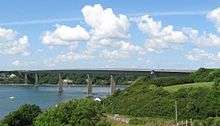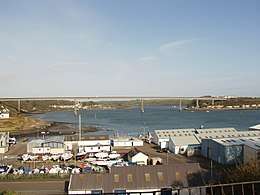Cleddau Bridge
| Cleddau Bridge | |
|---|---|
 | |
| Coordinates | 51°42′23″N 4°56′01″W / 51.7063°N 4.9337°WCoordinates: 51°42′23″N 4°56′01″W / 51.7063°N 4.9337°W |
| Carries | A477 traffic, pedestrians and bicycles |
| Crosses | River Cleddau |
| Locale | Pembrokeshire, Wales |
| Maintained by | Pembrokeshire County Council |
| Characteristics | |
| Design | Box girder |
| Total length | 0.51 miles (0.82 km) |
| History | |
| Opened | 20 March 1975 |
| Statistics | |
| Daily traffic | 10,905 |
| Toll |
£0.35 (Motorcycles & tricycles) £0.75 (cars & vans) £1.50 (larger vehicles)[1] |
The Cleddau Bridge (pronounced [ˈklɛðai], Welsh: Pont Cleddau) is a toll bridge in Pembrokeshire that carries the A477 road, and was originally called the Milford Haven Bridge. It spans the River Cleddau between Neyland and Pembroke Dock, South Wales. Toll booths are located on the Pembroke Dock side of the bridge. Since 1993, the charges are £0.75 for cars and vans; £1.50 for buses and lorries over 2 tonnes; no charge for cycles and pedestrians.
Errors in the box girder design caused it to collapse during its construction in 1970. The bridge became operational during 1975. The bridge is managed by Pembrokeshire County Council.[2]

History
The River Cleddau divides Pembrokeshire; Pembroke Dock on the south side and Neyland on the north side are less than 1 mile (1.6 km) apart across the water but a 28 miles (45 km) journey by road is required to travel from one to the other. Between 1858 and 1950 the Admiralty permitted operation of steam ferries between the two towns. From 1950, the County Council operated a ferry service, with capacity for 24 vehicles and 250 pedestrians.
A decision was taken in the 1960s to replace the ferry service: two bridges would be required, one crossing the Cleddau and a smaller bridge to the north of Neyland crossing Westfield Pill creek. Sir Alexander Gibb & Partners and Freeman Fox and Partners (now part of Hyder Consulting) were appointed as joint consulting engineers and the contract to build the bridge was awarded to A.E. Farr Limited in September 1968 for £2.1 million.
The project was expected to be completed by March 1971 but on 2 June 1970 a 230 feet (70 m) cantilever being used to put one of the 150-tonne sections into position collapsed on the south side of the estuary. Four workers died and five were injured. Construction was halted until October 1972. The Merrison Committee of Inquiry into the Design and Erection of Steel Box Girder Bridges concluded that the cause of the collapse was the inadequacy of the design of a pier support diaphragm (a diaphragm of half the designed thickness was used),[3] but considered "the failure of site organisation between the parties as of more general significance".[4] The committee believed that the only relevant Code of Practice relating to the design of steel bridges in the UK was inadequate for applications such as the Cleddau Bridge, and they implemented Interim Design and Workmanship Rules.[5] These rules lay the groundwork for a new British Standard covering box girder bridge design.[6] As of 2007, the collapse during construction is regarded as the last major bridge disaster in the UK.[7]
The final cost of construction was £11.83 million and the bridge was opened to traffic on 20 March 1975. The £7 million of overspend was attributed to design changes made due to the Merrison Committee's recommendations. This was covered by a £3 million out-of-court settlement between the County Council and the consulting engineers and a £4 million interest-free loan from the Government that was repayable over 40 years.[8] 885,900 crossings were made during the bridge's first year in operation.[9]
The ferry service that crossed the Cleddau from Hobbs Point in Pembroke Dock to Neyland ceased when the construction of the Cleddau Bridge was completed in 1975. The ferry Cleddau King was sold, modified by Harland and Wolff of Belfast and put into operation as a reserve Portaferry–Strangford ferry in Northern Ireland.[10]
Tolls
| Year | Cars & vans | Heavy vehicles |
|---|---|---|
| 1975 | 30p | 60p |
| 1979 | 35p | 70p |
| 1985 | 50p | £1.00 |
| 1993 | 75p | £1.50 |
The bridge is funded by tolls which are collected on the Pembroke Dock side of the bridge from traffic travelling in both directions. The present toll rates have been in place since 1993 and are 35p for motorcycles, 75p for cars and £1.50 for heavy vehicles; pedestrians and cyclists are free of charge. Car drivers may also buy books of 20 or 50 bridge tickets which reduces the cost to 60p per crossing. The toll booths only accept cash or the pre-purchased tickets. Toll booths with barriers were introduced in September 2004 to reduce the number of vehicles driving through without paying.[11] A review into the collection of tolls was carried out in early 2016,[12] following which, Pembrokeshire County Councillors voted that tolls charges would remain unchanged and not be abolished.[13]
Closures
The county council may close the bridge depending on wind speed, wind direction and the weather forecast. Vehicles taller than 1.9 m (6 ft 3 in), bicycles and motorcycles are usually not permitted to cross the bridge when wind speeds exceed 50 mph (80 km/h). The bridge is closed to all vehicles and pedestrians should wind speeds exceed 70 mph (110 km/h). The council records the time the bridge is closed.[14]
See also
References
| Wikimedia Commons has media related to Cleddau Bridge. |
- ↑ "Cleddau Bridge Toll Charges". Pembrokeshire County Council. Retrieved 30 June 2018.
- ↑ "Cleddau Bridge Toll". Pembrokeshire County Council.
- ↑ Department of the Environment (Merrison Committee of Inquiry) (1973). Inquiry into the Basis of Design and Method of Erection of Steel Box Girder Bridges. London: HMSO.
- ↑ Bridle, Ron; Porter, John (2002). The Motorway Achievement: Frontiers of Knowledge and Practice. Thomas Telford Ltd. pp. 346–348. ISBN 978-0-7277-3197-5.
- ↑ Department of the Environment (Merrison Committee of Inquiry) (1973). "Appendix 1: Interim Design and Workmanship Rules.". Inquiry into the Basis of Design and Method of Erection of Steel Box Girder Bridges. London: HMSO.
- ↑ Flint, A.R. "Steel Box Girder Bridges". Institution of Structural Engineers. Archived from the original on 30 January 2008. Retrieved 30 January 2008.
- ↑ "How safe are our bridges?". BBC News. 3 August 2007. Retrieved 30 January 2008.
The last major bridge disaster in the UK was the collapse of Pembrokeshire's Cleddau Bridge during construction in 1970, killing four people.
- ↑ "Cleddau Bridge". Hansard. 8 December 1994.
- ↑ "Cleddau Bridge". Pembrokeshire County Council. Archived from the original on 30 January 2008. Retrieved 30 January 2008.
- ↑ "Cleddau King". Shipspotting. Retrieved 10 August 2013.
- ↑ "Abuse plea over toll collectors". BBC News. 3 September 2004. Retrieved 30 January 2008.
- ↑ "Pembrokeshire toll bridge to be reviewed after complaint". BBC News. 4 September 2015.
- ↑ "Pembrokeshire's Cleddau Bridge tolls to stay the same". BBC News. 13 May 2016.
- ↑ "Cleddau Bridge: Current Bridge Status". Pembrokeshire County Council. Retrieved 22 January 2017.